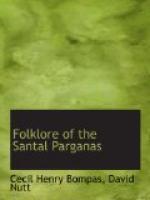CXXXVII. The Thief’s Son.
Once upon a time a goat strayed into the house of a certain man who promptly killed it and hid the body. At evening the owner of the goat missed it and came in search of it. He asked the man who had killed it whether he had seen it, but the latter put on an innocent air and declared that he knew nothing about it but he invited the owner of the missing animal to look into the goat house and see if it had accidentally got mixed up with the other goats. The search was of course in vain.
Directly the owner had gone the thief brought out the body and skinned and cut it up, and every one in the house ate his fill of flesh. Before they went to sleep the thief told his sons to be careful not to go near any of the other boys when they were grazing the cattle next day, lest they should smell that they had been eating meat.
Next morning the thief’s son took his goats out to graze and was careful not to go near any of the other boys who were tending cattle; whenever they approached him he moved away. At last they asked him what was the matter; and he told them that they must keep at a distance lest they should smell what he had been eating. “What have you eaten?” The simpleton replied that he had been eating goat’s flesh and that there was still some in the house. The cowherds at once ran off and told the owner of the lost goat. The news soon spread and the villagers caught the man who had killed the goat and searched his house and found the flesh of the goat. Then they fined him one rupee four annas and made him give another goat in exchange for the one he had stolen.
CXXXVIII. The Divorce.
There was once a man who had reason to suspect his wife’s faithfulness. He first tried threatening and scolding her; but this had no good effect, for far from being ashamed she only gave him back harder words than she received. So he set to work to find some way of divorcing her without making a scandal. One day when he came home with a fine basket of fish which he had caught he found that his father-in-law




